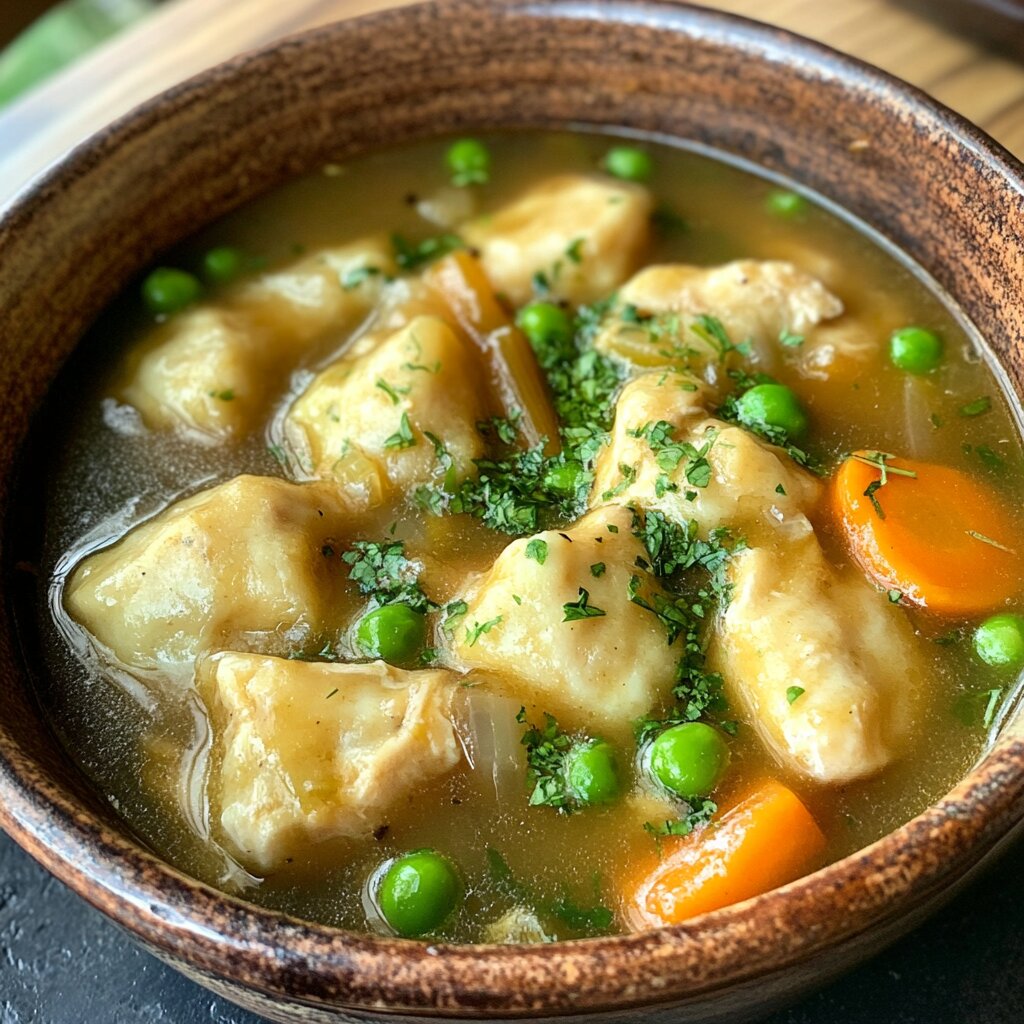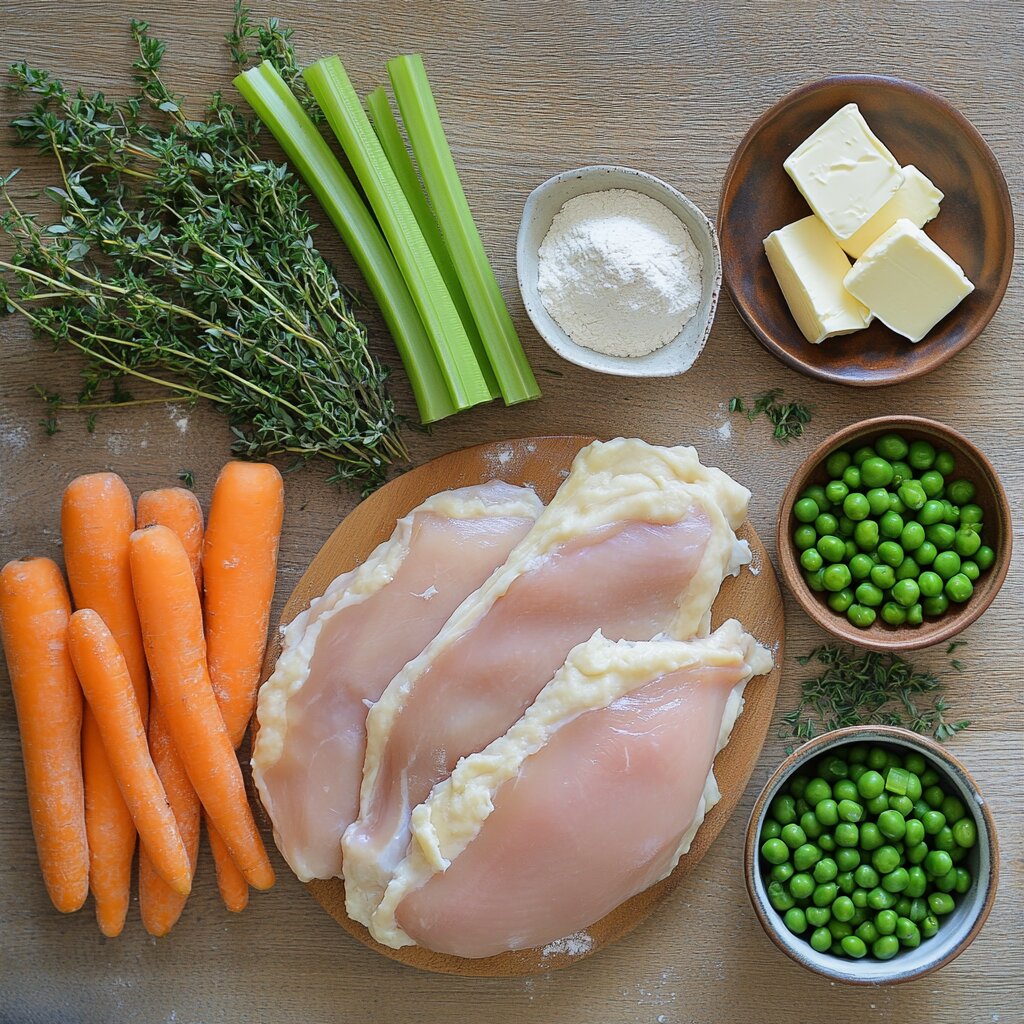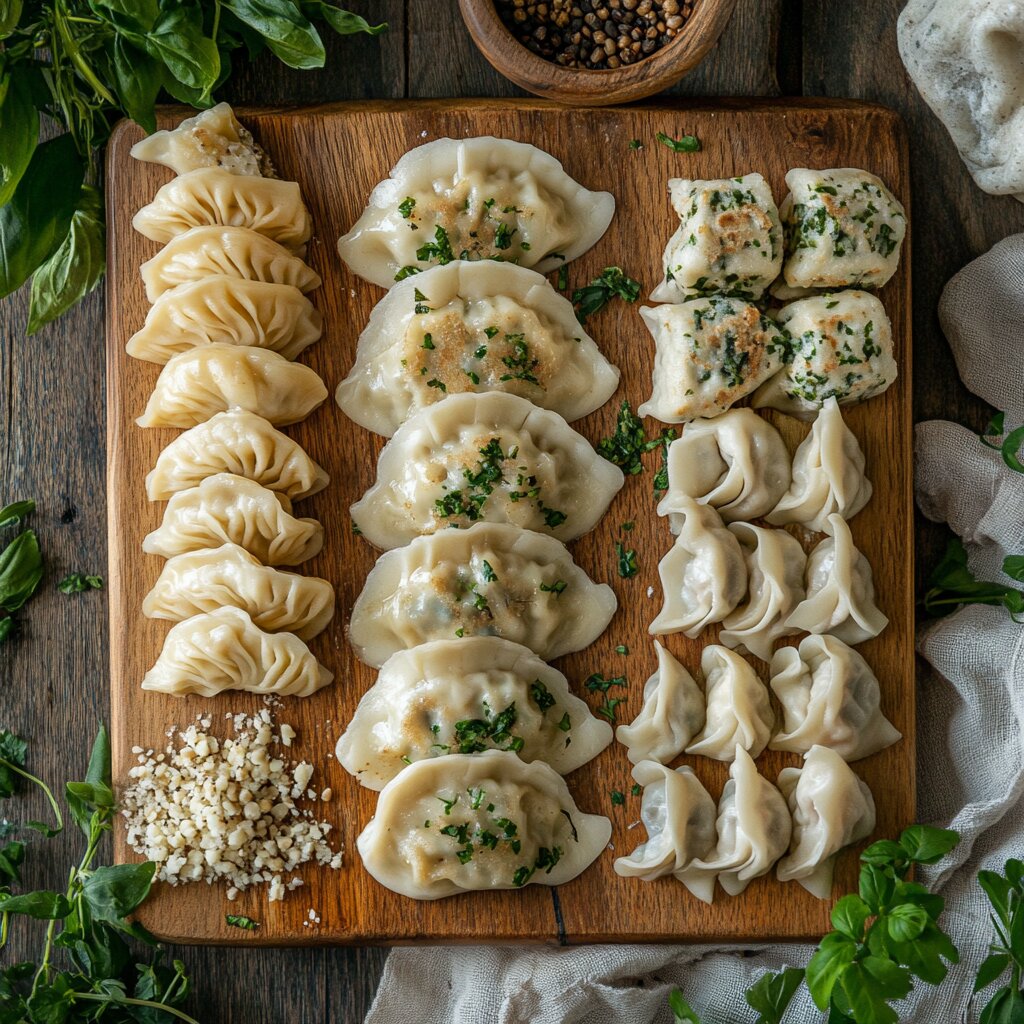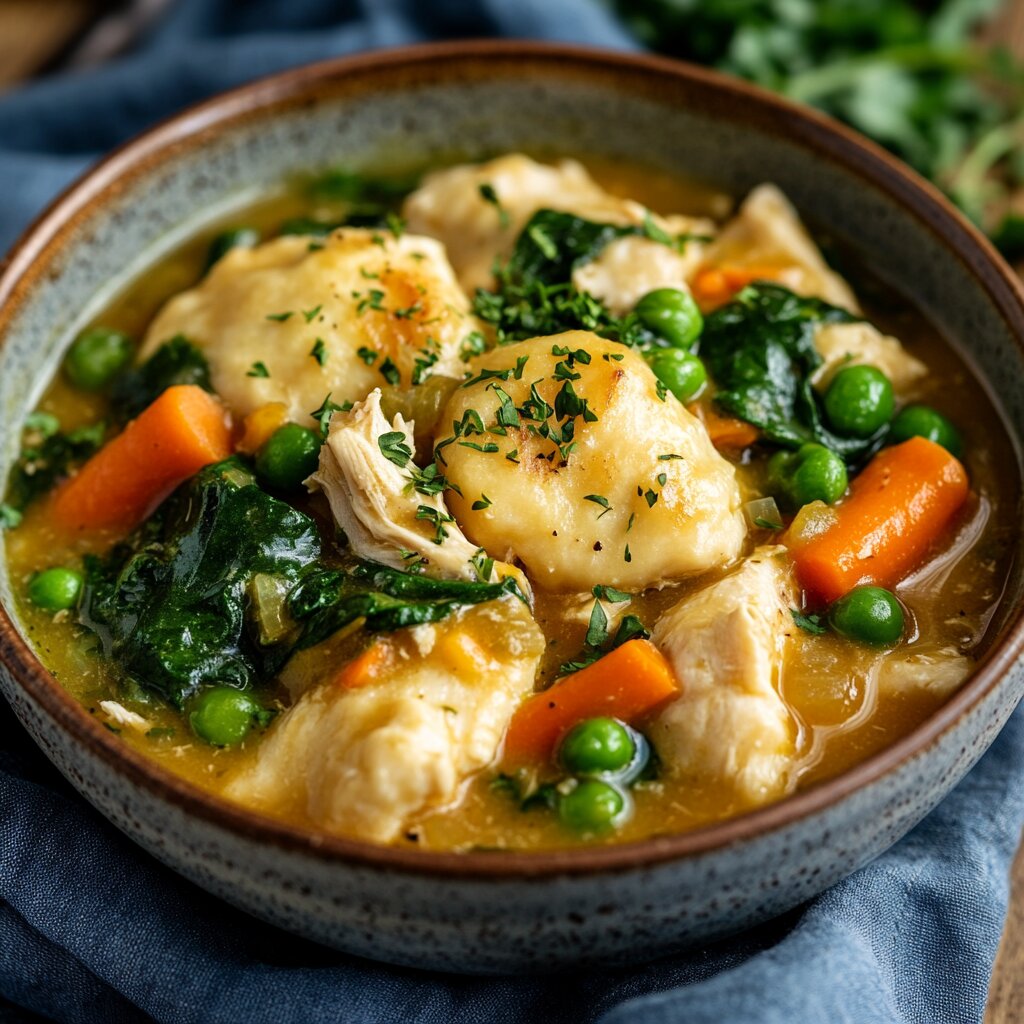
Chicken and dumplings offer a comforting meal that combines tender chicken with fluffy dumplings simmered in a savory broth. In this guide, we’ll explore the nutrition facts for chicken and dumplings, including calories, ingredients, and health tips. This dish consists of stewed chicken, thickened broth, and soft dough pieces that absorb the flavors. Many families prepare it during colder months for warmth and satisfaction.
The recipe typically includes chicken (breasts, thighs, or drumsticks), flour, butter, milk, and vegetables like carrots, celery, and peas. Different regions add their own touches, such as herbs, spices, or cream. You can prepare chicken and dumplings using methods like stovetop cooking, slow-cooking, or pressure-cooking. Its simplicity and versatility make it a beloved meal that brings comfort to households around the world.
Table of Contents
The Origin and History of Chicken and Dumplings
Chicken and dumplings trace their roots back to European settlers who brought traditional stews and dumpling recipes to North America. These settlers adapted their dishes using local ingredients. During the Great Depression, the dish became popular in the American South because it was affordable and filling. Adding dumplings helped stretch meals to feed large families.
Over time, different regions introduced unique variations. In some areas, cooks made dumplings with cornmeal, while others used potatoes. Despite these differences, the core elements of tender chicken and hearty dumplings remain unchanged. Many families continue to pass down this comforting recipe through generations, preserving its history and tradition.
Ingredients Commonly Used in Chicken and Dumplings

Chicken: Types and Cuts
Different cuts of chicken influence the dish’s flavor, texture, and nutrition. Chicken breasts are a lean choice, providing about 26 grams of protein per 3-ounce serving. For a juicier option, chicken thighs work well because they contain more fat, which adds richness to the broth. Drumsticks are an affordable choice that contributes deep, savory flavors.
Some recipes use a whole chicken, combining white and dark meat for a balanced taste. Bone-in cuts enhance the broth by releasing marrow during cooking. Regardless of the cut, chicken adds essential nutrients like protein, B vitamins, and minerals such as iron and zinc. Choosing the right cut allows you to tailor the dish to your taste and nutritional needs.
Dumplings: Types and Preparation Methods
Dumplings are a key part of this dish, and their preparation method affects the texture and taste. Drop dumplings are made by spooning wet batter into the simmering broth. They turn into soft, pillowy bites that soak up the stew’s flavors. In contrast, rolled dumplings use a firmer dough that is flattened and cut into strips or shapes. These dumplings have a chewier texture.

For convenience, many people use Bisquick dumplings, which rely on pre-made baking mix. Adding herbs like parsley, thyme, or dill creates herbed dumplings with enhanced flavor. If you need a gluten-free version, substitute almond flour or a gluten-free mix for traditional flour. This flexibility allows you to adapt dumplings to various tastes and dietary needs.
Detailed Nutrition Facts for Chicken and Dumplings
Calorie Content Breakdown
A typical 1-cup serving of chicken and dumplings contains 300-400 calories, depending on ingredients and portion size. Understanding the nutrition facts for chicken and dumplings helps you manage your caloric intake. Understanding the nutrition facts for chicken and dumplings helps you manage your caloric intake. The chicken portion contributes about 150-200 calories, with variations based on the cut used. Dumplings add another 120-180 calories, depending on the type of flour or fat included. Using butter, cream, or rich broth increases the calorie count.
Making the dish at home allows you to control calories by choosing lean chicken, whole-wheat flour, and low-fat dairy. To reduce calories, limit the number of dumplings or replace them with lighter alternatives. Watching portion sizes also helps you enjoy this dish without exceeding your daily calorie goals.
Macronutrient Profile
Protein Content
Nutrition facts for chicken and dumplings show that this dish delivers a good amount of protein, primarily from the chicken. A 3-ounce serving of chicken breast offers about 26 grams of protein. Chicken thighs provide slightly less protein but contribute more flavor due to their fat content. Dumplings add 2-4 grams of protein per serving, depending on the flour type used.
Boost the protein content by adding extra chicken or legumes like white beans to the broth. Protein supports muscle repair, growth, and overall bodily function. Including more protein-rich ingredients in the dish ensures a balanced, satisfying meal that meets daily nutritional needs.
Carbohydrate Content
Carbohydrates come mainly from dumplings, with a typical serving containing 30-40 grams of carbs. Dumplings made with white flour provide simple carbohydrates, offering quick energy. For a healthier option, use whole-wheat flour, which adds fiber and aids digestion. Vegetables like carrots, celery, and peas also supply small amounts of complex carbs.
If you follow a low-carb diet, consider alternatives like almond flour or cauliflower-based dumplings. These options reduce the overall carbohydrate content while maintaining the dish’s heartiness. Balancing dumplings with chicken and vegetables can create a meal that satisfies hunger and provides lasting energy.
Fat Content
The fat content varies depending on the chicken cut and preparation method. Chicken thighs and drumsticks contain about 10 grams of fat per serving, while chicken breasts offer a leaner option with around 3-4 grams of fat. Dumplings made with butter, milk, or cream can add extra fat, contributing 10-15 grams of fat per serving overall.
To reduce fat, use lean chicken and low-fat milk instead of cream. Skim any excess fat from the broth before adding dumplings. For a healthier alternative to butter, try olive oil. By controlling fat content, you can enjoy this comforting dish while maintaining a balanced diet.
Micronutrients and Vitamins
Chicken and dumplings provide a range of essential micronutrients and vitamins that contribute to overall health. The chicken offers significant amounts of vitamin B6 and niacin (B3), which help convert food into energy and support the nervous system. These B vitamins also play a role in maintaining healthy skin and cognitive function.
Vegetables often added to the dish, such as carrots, celery, and peas, contain vitamin A, which supports vision and immune function, and vitamin K, which helps with blood clotting and bone health. The broth can be a source of minerals like potassium and magnesium, which support heart health, muscle function, and hydration balance. Using bone-in chicken enriches the broth with additional nutrients like calcium and iron. To maximize nutritional value, incorporate a variety of vegetables and use herbs to enhance both flavor and health benefits.
Important Minerals
Chicken and dumplings also deliver several important minerals necessary for maintaining a healthy body. Chicken is a good source of iron, which supports the production of red blood cells and helps prevent anemia. The dish also contains zinc, which boosts the immune system and supports wound healing and cell growth. Vegetables like carrots and peas contribute additional minerals such as potassium and magnesium. Potassium helps regulate blood pressure, while magnesium aids in muscle function and energy production.
If you use dairy or cream in the recipe, you’ll also get a boost of calcium, essential for strong bones and teeth. Broth made from bone-in chicken provides trace minerals like phosphorus and sodium. While sodium is necessary for bodily function, it’s important to monitor its intake to avoid excessive consumption. Opt for low-sodium broth and fresh herbs to maintain a balanced mineral profile.
For a deeper dive into this dish, check out the Complete Guide to Chicken and Dumplings Nutrition
Health Benefits of Chicken and Dumplings
Protein for Muscle Growth and Repair
Nutrition facts for chicken and dumplings reveal that this dish offers an excellent source of protein, which supports muscle growth, repair, and overall bodily function. Protein is essential for building and maintaining muscle tissue, making this dish a satisfying option for those with active lifestyles or anyone looking to meet their daily protein needs. Chicken breasts provide a lean source of protein, while thighs offer a slightly higher fat content, enhancing the dish’s flavor.
Adding extra chicken or incorporating legumes like beans can boost the protein content further. Protein also supports enzyme production, immune function, and hormone regulation. Including chicken and dumplings as part of a balanced diet helps maintain strength, repair tissues, and keep your body functioning efficiently. This makes the dish a nutritious and satisfying meal option.
Energy-Boosting Carbohydrates
The dumplings in chicken and dumplings provide a substantial source of carbohydrates, which serve as the body’s primary energy source. Carbs break down into glucose, giving you the fuel needed for physical activity and brain function. The simple carbohydrates from white flour offer quick energy, while using whole-wheat flour adds fiber, which helps with digestion and provides longer-lasting energy.
Adding vegetables like carrots, peas, and celery increases the dish’s fiber and nutrient content. These complex carbohydrates help stabilize blood sugar levels and keep you feeling full longer. If you are looking for a healthier version, consider using whole-grain or alternative flour for the dumplings. This ensures the dish remains energizing without causing energy crashes.
Key Vitamins for Overall Health
Chicken and dumplings deliver essential vitamins that support overall health and well-being. Chicken contains B vitamins, such as niacin and vitamin B6, which help convert food into energy and support brain function. These vitamins also play a role in maintaining healthy skin, nerve function, and metabolism.
Vegetables like carrots provide vitamin A, which supports vision, while peas and celery add vitamin K, which aids in bone health and blood clotting. Including herbs like parsley or thyme can boost the dish’s vitamin C content, helping with immune support and antioxidant protection. By incorporating a variety of nutrient-dense ingredients, chicken and dumplings can be both a comforting and healthful meal that supports overall wellness.
Potential Health Concerns
High Sodium Levels
One potential health concern with chicken and dumplings is its sodium content. Broth, pre-made dumpling mixes, and seasonings can contribute high levels of sodium. Excessive sodium intake can lead to high blood pressure, heart disease, and fluid retention. To reduce sodium, use low-sodium broth or make your own broth from scratch. Limit the use of salt during cooking and enhance flavor with herbs and spices instead.
For store-bought dumpling mixes, check the labels for sodium content and opt for low-sodium varieties when possible. Adding more vegetables can also help balance the dish’s sodium content. Being mindful of sodium intake allows you to enjoy chicken and dumplings without compromising heart health.
Caloric Density and Weight Management
Chicken and dumplings can be high in calories due to the combination of dumplings, rich broth, and chicken. A typical serving ranges from 300-400 calories, but adding butter, cream, or large portions of dumplings can increase this significantly. Consuming high-calorie meals regularly can contribute to weight gain.
To manage caloric intake, use lean chicken breasts instead of thighs, and opt for whole-wheat dumplings to add fiber and reduce empty calories. Skim any excess fat from the broth and avoid adding heavy cream. Reducing the portion size of dumplings and increasing the amount of vegetables can also help. These adjustments allow you to enjoy this comforting dish while supporting a balanced diet and healthy weight.
How to Make Healthier Chicken and Dumplings

Ingredient Substitutions
Making simple ingredient substitutions can significantly improve the nutrition facts for chicken and dumplings. Replace chicken thighs with chicken breasts to reduce fat and calories. Instead of white flour, use whole-wheat flour or gluten-free alternatives for the dumplings to increase fiber and make the dish more suitable for different dietary needs. Swap out heavy cream for low-fat milk or unsweetened almond milk to reduce fat content.
To boost nutrients, add extra vegetables like spinach, kale, or green beans. Use low-sodium broth to keep sodium levels in check, and season the dish with herbs like thyme, rosemary, or parsley for flavor without added salt. These substitutions help create a healthier version of this classic comfort dish.
For a unique twist, consider this Chicken and Dumplings with Tortillas.
Cooking Methods for Better Nutrition
Choosing the right cooking methods can enhance the nutrition facts for chicken and dumplings. Instead of frying dumplings, steam or simmer them directly in the broth to keep the fat content low. Opt for boiling or pressure-cooking the chicken rather than pan-frying to avoid unnecessary added fats.
Skim any excess fat from the broth before adding the dumplings, and use low-sodium or homemade broth to control salt content. Adding fresh vegetables during cooking increases nutrient density without increasing calories. These cooking techniques allow you to enjoy a healthier version of chicken and dumplings while maintaining its comforting and satisfying qualities.
Looking for variations? Try this Ultimate Chicken Dumpling Soup Recipe.
Comparing Homemade vs. Store-Bought
Nutritional Differences
Homemade chicken and dumplings offer more control over ingredients, which allows for better nutrition management. When preparing the dish at home, you can choose lean chicken, add fresh vegetables, and use whole-wheat flour for dumplings. This approach increases fiber and reduces unhealthy fats and sodium. Homemade recipes typically contain fewer calories, lower sodium levels, and no artificial additives or preservatives. You also have the flexibility to adjust portion sizes to meet dietary goals.
In contrast, store-bought versions often rely on pre-made broths, canned soups, or packaged dumplings. These products can be high in sodium, unhealthy fats, and preservatives like MSG (monosodium glutamate) or sodium benzoate. Many packaged options use refined white flour, which lacks the fiber and nutrients of whole grains. While store-bought versions are convenient, the nutritional trade-offs can impact overall health. Preparing chicken and dumplings at home ensures a healthier, fresher meal.
Preservatives and Additives in Store-Bought Options
Store-bought chicken and dumplings often contain preservatives and additives to extend shelf life and enhance flavor. Common additives include monosodium glutamate (MSG), which boosts umami flavor but can cause sensitivity in some people, and sodium benzoate, used to prevent spoilage. These ingredients can contribute to inflammation, headaches, and other adverse effects when consumed frequently.
Packaged dumpling mixes may also contain artificial flavor enhancers, colorings, and hydrogenated oils, which add trans fats to the diet. Pre-made broths and canned soups tend to have high sodium levels, sometimes exceeding daily recommended limits. While these options save time, they often compromise on nutritional quality. Reading labels carefully and selecting low-sodium, additive-free products can help mitigate these issues. However, making chicken and dumplings from scratch remains the best way to avoid preservatives and control the ingredients.
Serving Suggestions and Pairings
Side Dishes That Complement Nutrition
Pairing chicken and dumplings with nutrient-rich side dishes can create a balanced meal. Steamed vegetables like broccoli, green beans, or asparagus add fiber, vitamins, and minerals without increasing calories significantly. These sides provide a crunchy contrast to the soft dumplings and add color to the plate.
A fresh green salad with a light vinaigrette offers additional nutrients and fiber, promoting digestion and satiety. Adding ingredients like cherry tomatoes, cucumbers, and avocado boosts the salad’s nutritional value. For a heartier option, serve chicken and dumplings with whole-grain bread or cornbread, which provides complex carbohydrates and fiber.
To enhance flavor without adding extra calories, consider garnishing the dish with fresh herbs like parsley or thyme. These pairings balance the richness of chicken and dumplings, making the meal more satisfying and nutritious.
FAQs About Nutrition Facts for Chicken and Dumplings
Is Chicken and Dumplings a Balanced Meal?
Yes, chicken and dumplings can be a balanced meal if prepared mindfully. The dish provides protein from chicken, carbohydrates from dumplings, and essential vitamins and minerals from vegetables and broth. To make it healthier, use lean chicken breasts, whole-wheat dumplings, and plenty of vegetables like carrots, peas, and celery. This combination delivers a good mix of protein, fiber, and nutrients.
For added balance, pair the dish with a side of steamed vegetables or a fresh green salad. This helps ensure you’re getting enough fiber and micronutrients. Being mindful of portion sizes and ingredients helps keep chicken and dumplings a satisfying and nutritious part of your diet.
How Can I Reduce Sodium in Chicken and Dumplings?
Reducing sodium in chicken and dumplings is achievable with a few simple adjustments. Use low-sodium chicken broth or make your own broth from scratch to control salt content. Avoid using pre-made dumpling mixes, which often contain added sodium. Instead, make dumplings from scratch with whole-wheat flour and unsalted butter or oil.
Season the dish with herbs and spices like thyme, rosemary, or garlic instead of salt. Adding vegetables like carrots, celery, and peas enhances flavor naturally. When using salt, add it sparingly and taste the dish before adding more. These changes significantly reduce sodium without compromising taste.
Are Chicken and Dumplings Suitable for a Low-Calorie Diet?
Yes, chicken and dumplings can fit into a low-calorie diet with the right modifications. Use chicken breasts instead of thighs to reduce fat and calories. Opt for whole-wheat flour or gluten-free flour for the dumplings to add fiber without increasing calories. Replace cream or whole milk with low-fat milk or unsweetened plant-based alternatives to lighten the dish.
Limit the number of dumplings or make smaller portions to reduce caloric intake. Increase the amount of vegetables like carrots, peas, and celery to add volume and nutrients without many calories. These adjustments allow you to enjoy chicken and dumplings while staying within your calorie goals.
What Are the Best Dumpling Alternatives for Low-Carb Diets?
For those on a low-carb diet, there are several dumpling alternatives to consider. Replace traditional dumplings with cauliflower dumplings made from steamed, mashed cauliflower mixed with eggs and almond flour. These provide a similar texture without the carbs. Almond flour dumplings or coconut flour dumplings are also excellent low-carb options.
Zucchini noodles or spiralized vegetables can replace dumplings entirely for a lighter, carb-free version of the dish. Adding more chicken and low-carb vegetables like spinach or green beans can help create a satisfying meal. These alternatives keep the dish flavorful and hearty while supporting low-carb dietary goals.
How Can I Boost the Protein Content of Chicken and Dumplings?
Boosting the protein content of chicken and dumplings is simple with a few modifications. Use extra chicken breast to increase the overall protein content. Adding legumes like white beans or chickpeas to the broth provides additional protein and fiber.
Consider mixing Greek yogurt or low-fat cottage cheese into the dumpling dough for an extra protein boost. You can also add a protein-rich garnish like parmesan cheese or toasted nuts for a different texture. These additions make chicken and dumplings more filling and nutritious, supporting muscle growth and overall health.
Can Chicken and Dumplings Be Made Gluten-Free?
Yes, chicken and dumplings can be made gluten-free with a few substitutions. Replace traditional flour in the dumplings with gluten-free flour blends, almond flour, or coconut flour. Make sure to use a gluten-free broth or prepare your own to avoid hidden gluten.
If thickening the broth, use cornstarch or arrowroot powder instead of flour. Ensure all seasonings and packaged ingredients are labeled gluten-free. By making these swaps, you can enjoy a gluten-free version of chicken and dumplings that’s just as delicious and comforting as the original.
Conclusion
Understanding the nutrition facts for chicken and dumplings ensures you can enjoy this comforting, nutritious meal while meeting your dietary needs. By understanding the ingredients, nutritional content, and potential health concerns, you can make healthier choices while enjoying this classic dish. Whether you prepare it with lean chicken, whole-wheat dumplings, or add extra vegetables, chicken and dumplings can be a balanced and satisfying part of your meal plan. With mindful preparation, this timeless comfort food continues to nourish and delight generations.
